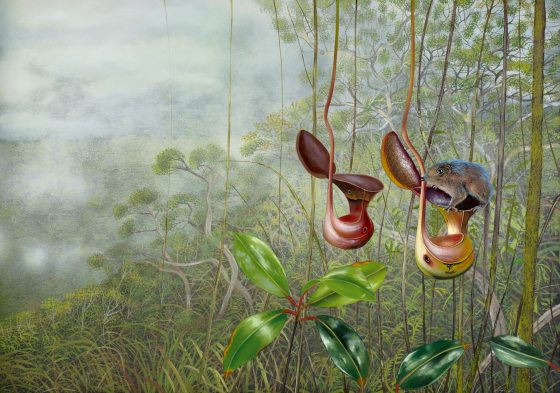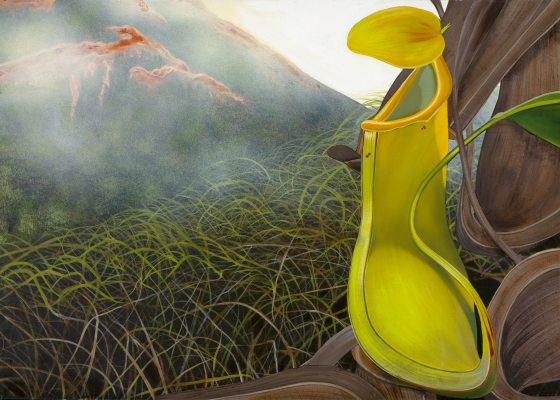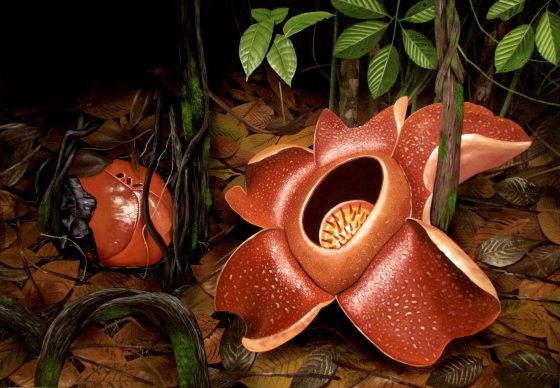Read. Think. Engage. These are the goals of every Longwood Gardens Community Read. This year, author-artist Chris Thorogood invites you to engage with plants that have long captured his imagination, inspired his art, and shaped his career—he calls them (and his stunningly illustrated book) Weird Plants. From Middle Eastern deserts to tropical Borneo, Thorogood has hunted, studied, and painted parasitic and carnivorous plants, focusing his research on evolutionary genetics, plant taxonomy, and biodiversity hotspots. But his fascination with plants goes back to his childhood.
“I crammed my windowsill full of botanical oddities including succulents, tropical pitcher plants in glass tanks, and even potted ‘squirting cucumbers’—plants with fruits that explode and disperse their seeds far and wide—in this case all over my bedroom wall.”
At age 12, Thorogood wrote a letter to Kew Gardens, London, asking for seeds of broomrape—a plant that steals its food from the roots of other plants. “I managed to grow it and was so thrilled because they are believed to be tricky to cultivate. Once I had started to grow parasitic ‘vampire plants,’ there was no stopping me!”
Now Deputy Director and Head of Science for the University of Oxford Botanic Garden and Arboretum, Thorogood recently took time to answer our questions about science, art, and his upcoming visit to Longwood Gardens.

Where has your study of Weird Plants taken you? Can you share a particularly memorable experience?
My job has taken me to beautiful, exciting, and at times dangerous places. A particularly fond memory for me was encountering the king pitcher plant on Mount Kinabalu in Borneo. It had been a lifelong ambition to see this plant in the single place in which it grows, and at the age of 21, I made my first ascent of the mountain to find it. Standing there on a steep misty hillside with the sound of waterfalls in the distance, surrounded by these magnificent plants, is an unforgettable memory that is just without compare.
What is one of the most surprising discoveries you’ve made? What recent developments in science have made your research possible?
A former research project I worked on showed that parasitic plants—those that steal food from other plants—can form new species right under our noses without us even realizing! Because these strange plants lack some of the features that most plants have—leaves, for example—they can be tricky for botanists to tell apart. By looking at the DNA sequences of these plants, I discovered that seemingly identical populations of parasitic plants are in fact genetically different, and forming new species without us realizing.

What practical applications have resulted from your research?
Recently I worked with other scientists to understand how the slippery surfaces of carnivorous pitcher plants work, and how this might have applications in industry. Our work showed that liquid droplets move across the specialized surface in a very controlled way. This suggests that insects may be driven into the plants’ traps in a way that is much more precise than we realized previously. These special surfaces can have applications in industry where it is necessary to control the movement of water, for example in anti-fogging devices, or in microfluidics.
How is climate change affecting these plants? Where are Earth’s biodiversity hotspots and how rapidly are they changing?
This is an interesting question and the truth is that we do not know for sure. We do know that climate change is shifting the distributions of plants in many parts of the world, and that global biodiversity is in decline generally; the consequences of this could be devastating. Biodiversity hotspots are regions that are particularly rich in diversity that are also threatened by human impact. These are useful places with which to measure change. Some of my work centers on the biodiversity hotspot of Japan where, together with local botanists, we are quantifying the diversity of plant richness in different types of vegetation across the country, with a view to informing conservation priorities there.

What are some of the Weird Plants you’ve been able to cultivate at Oxford Botanic Garden? What advice do you have for Community Readers who would like to cultivate one or more of their own “botanical oddities”?
I am keen for us to cultivate as many parasitic plants as I can at Oxford Botanic Garden because they are represented so poorly in botanic gardens internationally. We have created a small but growing collection in Oxford that we are planning to develop in the coming years.
My advice for Community Readers would be to have a go at some of the carnivorous plants that are often highly decorative as well as unusual. A sunny windowsill is a great place to try sundews, Venus’ flytraps, and North American pitcher-plants. Remember to use rainwater if you can (they object to tap water)—plenty of it in summer, and lay back a little in winter. Or if you are more of the “neglectful” gardener, try succulents—they are very forgiving providing you do not overwater them in winter. I leave mine for weeks at a time when I travel. A personal favorite? The “golf ball cactus,” which really couldn’t have any other name—look it up and you’ll see what I mean!

Can you tell us a little about your artistic process?
Painting has always been an important part of my life. With a paintbrush in hand, I can recreate the beautiful plants and places I have been fortunate enough to see in the wild, slowly conjuring to canvas a dusty desert plain, or a thriving rainforest thicket, staging the plant I plan to illustrate.
I scribble and take notes, and take lots of photographs in the field. My preferred medium is oil paint; however, it is not practical to use these paints “on the go” because they have such a long drying time (sometimes weeks). So I refer to my notes, sketches, and photographs whilst I paint back in my studio in Oxfordshire.
Marianne North was a prolific English Victorian botanical artist who did paint with oils in the field around the world; although her paintings have less precision than watercolors that were more common at the time, they have a depth to them that I do not think can be achieved so easily with other media. Like North did, I suppose, I like how oils can really capture the very essence and feel of the plants that I am illustrating; if I feel that I can reach out and touch them, then I know I’ve achieved what I set out to do.
Why is public engagement important for science and scientists?
It is so important for plant scientists to engage people with their work. Many people think that plant biology is unexciting, often because of how it was taught to them at school, or because plants may seem a little inanimate compared with animals. But there is so much more to plant biology than just photosynthesis, for example. That is why I love “weird plants” so much: they have the power to transform people’s perceptions about plants: they really turn the tables on animals because they dupe, kidnap, and even kill them!

For other (not so scary) Community Read happenings—be sure to browse our full list of partner-sponsored events.



